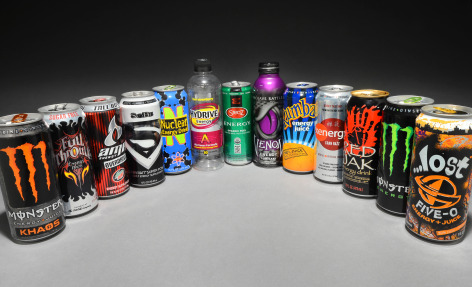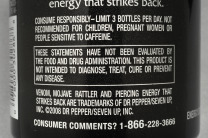
Most energy drinks contain as much caffeine as five cups of coffee, but some teens think they are safe or some type of sports drink. Photo by Bob Elbert (Larger image)
AMES, Iowa – Look closely at the label of any energy drink and you will likely notice a key ingredient is missing. Despite the fact that many of these popular drinks contain as much as 500 mg of caffeine, you won’t find the amount listed on the can or bottle.
The omission could explain why a study by the Centers for Disease Control and Prevention found 20 percent of young people who consume energy drinks think they are safe, said Ruth Litchfield, an associate professor and associate chair of food science and human nutrition at Iowa State University. Another 13 percent perceive that energy drinks are a type of sports drink.
“These drinks have this connotation that they are a performance enhancer because they’re an energy drink. Whether that performance is academic or physical, that’s the perception,” Litchfield said. “You’re talking about the equivalent of five cups of coffee in one energy drink. And it’s not just youth who are unaware, it’s adults. I’ve seen adults in the grocery store buying these energy drinks for their children.”
Caffeine is not Litchfield’s only concern. Ma huang (also known as ephedra) and guarana are stimulants that are also added to energy drinks. If teens and young adults – which make up about half of the energy drink market, according to the CDC – believe these drinks are safe they may underestimate the health risks.

Caffeine may not be on the nutrition panel, but some energy drinks do come with a warning if you read the fine print. Photo by Bob Elbert (Larger image)
“That amount of caffeine has health implications. Your heart rate and blood pressure will increase and you’ll have increased risk for arrhythmias. If you consistently consume these for a prolonged period of time, you’re increasing your risk for cardiovascular disease,” Litchfield said.
Study emphasizes need for new rules in schools
Instead of a nutrition facts panel, consumers will find many energy drinks will have a supplement facts panel on the can or bottle. Litchfield says this allows energy drinks to bypass the process for approval by the Food and Drug Administration before the product is marketed and sold.
Even with its proposed changes for new nutrition labels, the FDA does not require caffeine to be included. Unless a company voluntarily lists the amounts for caffeine, ma huang or guarana, there is no way for consumers to know how much is added to an energy drink.
Litchfield says the lack of nutrition information and misperceptions by teens emphasizes the need for awareness. New USDA rules for drinks and snack foods sold in schools is a step in that direction. Many parents, students and school administrators have criticized the changes that limit what can be sold in vending machines and a la carte lines based on calories and portion size. But Litchfield says restricting these items sends a message to students and parents.
“Our schools are where we need to model and educate about what we know is in the best interest of children for long-term health,” Litchfield said. “If students don’t see these energy drinks in school, they start to understand there is a reason why.”
Litchfield hopes that doing more to educate students in middle school and high school will eventually change some of the habits she sees working with students on a college campus. While the CDC study found young people who consume energy drinks tend to have other poor health habits, Litchfield sees many otherwise health-conscious college students who rely on energy drinks for the caffeine boost.
Some cities and states have considered banning or restricting the sale of energy drinks to minors because of the potential health risks. While she knows it’s not popular, Litchfield says she is not opposed to the idea.
